NorthEast Radio Watch 12/8/2025: Cichon’s Back in Buffalo
In this week’s issue… Veteran newsman returns - Remembering NY's Leitner, RI's Jones - CT AM saved - Maine AM moves - "Indie" adds suburban signals
Text and photos by SCOTT FYBUSH
Make a list of the top local independent radio operators in the nation, and there’s a pretty good chance it will include Ben Downs’ Bryan Broadcasting cluster in Bryan-College Station, Texas.
It’s no exaggeration to say that our September 2019 travel routing might not even have included an overnight stop in College Station if not for the chance it provided to go visit Ben’s stations and sit down with him for a conversation (which you heard last year on the Top of the Tower Podcast, I hope – and if not, it’s just as interesting now as it was then.)

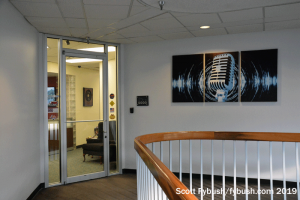
If you’re at all active in NAB, FCC or AM revitalization circles, you know Ben – he’s been one of the driving forces in AM radio regulation, stretching from the expanded-band era into today’s all-digital AM experiments.
Ben grew up in Hope, Arkansas, where he started doing radio at age 14 alongside another future broadcaster, Mike Huckabee. He came here as a Texas A&M student and started working at what would become the Bryan Broadcasting stations in 1972 – and here he’s remained ever since.
The Bryan Broadcasting cluster sits on the top floor of a bank office building on the frontage road along Texas 6, the freeway that bypasses the east side of College Station and Bryan (and eventually becomes the road that leads west to Waco, should you be headed that way.)

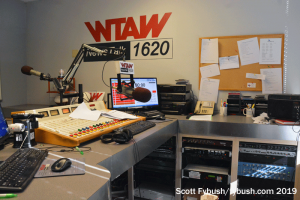
Traveling with Lance Venta of RadioInsight, we were flattered to see our logos on the monitor wall in the lobby as Ben welcomed us in and showed us down the long line of studios for the many signals and formats that make up this cluster.
There’s WTAW, one of the oldest callsigns in Texas. Today it’s on an expanded-band frequency, 1620, but that’s the offshoot (circa 2000) of a station that goes back to October 1922, when Texas A&M put WTAW on the air as a campus-based experimental station. In its early years, WTAW settled in at 1120 on the dial, sharing time with the University of Texas’ KUT and WJBO in Baton Rouge, Louisiana. (By 1930, KUT had moved to Houston and become KTRH, leaving the share-time and moving to 1290, 1320 and finally 740.)
With the addition of a directional array, WTAW was able to go full-time on its post-NARBA channel, 1150. In 1957, A&M sold the station to a commercial operator; several owners later, it ended up with Downs and Bryan Broadcasting. After the WTAW calls and news-talk format went to 1620 (and later to an FM translator at 94.5, as well), 1150 went all-sports as KZNE.


The original WTAW-FM was a class A at 92.1. Later known as KTSR, it eventually moved up the dial to 95.1 with more power, becoming “Candy 95.1,” KNDE, where we caught up with morning hosts Frito and Katy in their studio as their show was wrapping up.
The current 1150, KZNE, has its studio along the outside wall here, too, feeding not only the venerable AM signal but also a translator at 93.7.

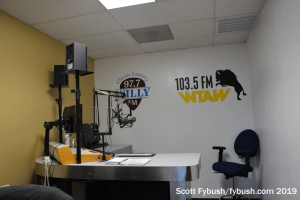
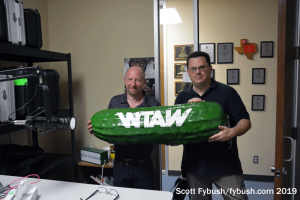
And there’s much more coming out of this building now, too. A mostly automated classic country format, “Willy,” airs on several signals: in Bryan-College station on a 97.7 translator fed by a KNDE subchannel, in nearby Navasota on a 98.7 translator fed by Bryan’s KWBC (1550 College Station), itself moved from Navasota a decade or so ago, and on WTAW-FM (103.5) in Buffalo, up along I-45 to the northwest.
There are two religious formats in small studios here, too. “Peace” is a Christian contemporary format heard on KPWJ (107.7 Kurten) here and on KKEE (101.3) to the east in Centerville. KAGC (1510 Bryan) does southern gospel, with a translator on 97.3.
There’s “red dirt” country on “the Maverick,” KMVK (100.9 Wheelock), a rimshot from the north.
There’s a Spanish-language format, “La Jefa,” fed by another KNDE HD subchannel to a translator on 102.7 – and there’s plenty of non-broadcast marketing happening here, too, with several lifestyle magazines (“Brazos Valley Bride”) coming from offices just down the hall from the radio studios.
(And why does WTAW have a giant pickle with its callsign in the studio? We still don’t know, either.)

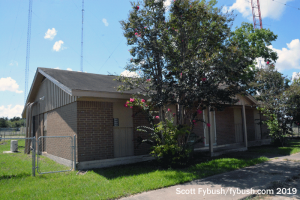
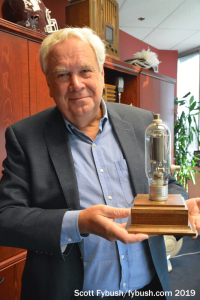
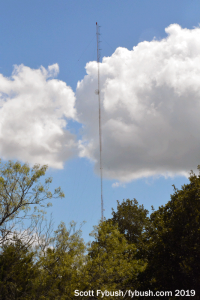
Let’s go look at some transmitter sites before we head out of the Brazos Valley for a long drive across East Texas to our next destination, shall we?
When WTAW moved to 1620, it built a new site out to the east, beyond the 6 bypass off the edge of what’s now a new housing development; its new tower is shared with sister station KPWJ.
The old WTAW 1150, now KZNE, has its three-tower site on the west side of College Station, at a location it moved to in 1960 after it had been sold and had to move off the A&M campus. (Its studios were here for a time in the 1960s, too.) It now runs 1000 watts non-directional by day, 500 watts into three towers at night.
KWBC’s 1550 signal now diplexes here, with 1500 watts by day and 50 watts at night, and there’s an aux here for KNDE, too, at what was surely the original WTAW-FM location.
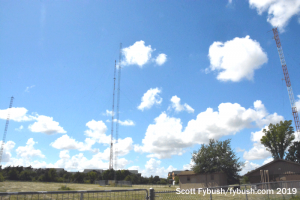
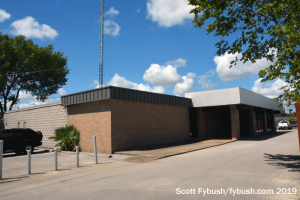
There are two other clusters here in town, too, in the unenviable position of competing with Downs. Brazos Valley Communications owns KTAM (1240), “Radio Alegria” with regional Mexican, and KORA (98.3), with country and the legendary Roger “WWW” Garrett in mornings. KTAM is the second-oldest station in town: it came on the air in 1947 as KORA, named for the owner’s mother. Its FM sister signed on in 1966; the AM eventually split off and took new calls named for Texas A&M. KTAM also has an FM translator on 100.1, and the whole shebang – AM, FM, translator and studios – are all on Villa Maria Drive in a bustling commercial district between downtown Bryan and College Station.
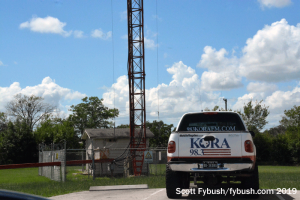
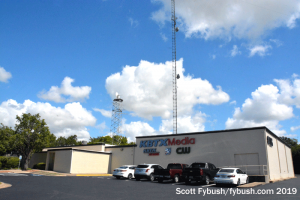
Bryan’s big TV station is just half a mile east of here, on E. 29th Street. KBTX (Channel 3) hit the air in 1957, bringing local TV to an area that had previously depended on big antennas to pull in signals from Houston, Temple and Waco. It’s nominally a satellite to KWTX-TV (Channel 10) in Waco, and because of that, Bryan and College Station became part of an ungainly artificial TV market that stretches westward for 70 miles or so to Temple and Waco, even though you can’t see the signals from here over there, or vice versa. (And KBTX, though considered a KWTX satellite, does its own separate local newscasts.)
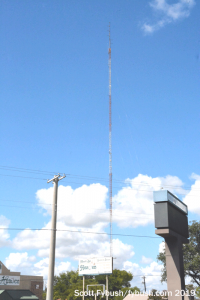
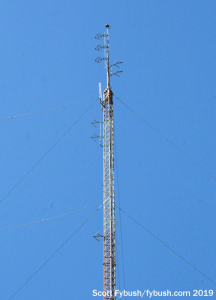
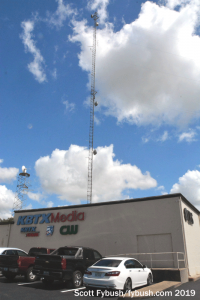
In 1983, KBTX moved to a taller tower near Anderson, out to the southeast of College Station, relegating the tower here on E. 29th Street to STL duty.
In more recent years, the other TV stations in the market have added signals of their own here in the Brazos Valley. Tegna-owned NBC affiliate KCEN (Channel 6) in Temple upgraded a translator into an LPTV station, now KAGS-LD (Channel 23), which originates separate weekday evening newscasts for the valley from studios on South Texas Avenue, a mile north of the A&M campus.

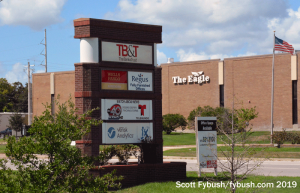
Fox for the valley comes via a subchannel of full-power KYLE (Channel 28), the MyNetwork station that’s now co-owned with Nexstar Fox affiliate KWKT (Channel 44) over in Waco; KYLE serves as the My station for both cities via a KWKT subchannel, while KWKT is now on the 28.2 sub of KYLE to reach the Brazos Valley.
And ABC gets to the valley on KRHD-CD (Channel 40), a satellite of KXXV in Waco. When we visited, there was no local news on KRHD, just a sales office in a big bank building down the street from the KORA/KTAM facility and up the street from KBTX.
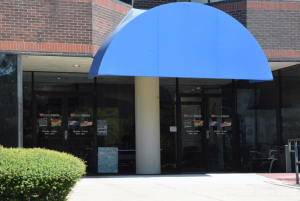
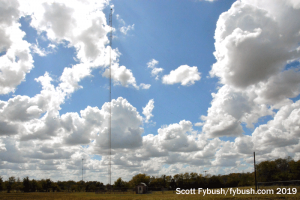
The building at 1716 Briarcrest Drive where KRHD has its sales office (and has, from time to time, done some local news) is right at the heart of the non-Ben Downs portion of the Bryan/College Station media landscape: the daily newspaper, the Eagle, is right across the street, KORA/KTAM and KBTX are less than a mile away – and what’s that on the roof and on the west side of the building?
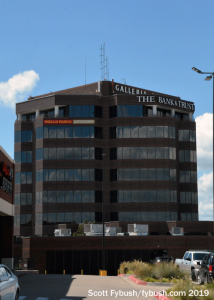
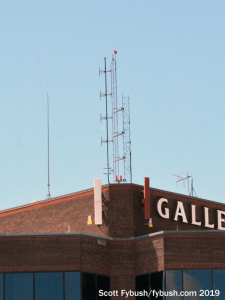
This is also where the iHeart cluster in town has its studio and some of its transmitters. The original Clear Channel actually owned KORA and KTAM for a while in the 1980s and 1990s, and then began assembling a new cluster here in the early 2000s. Classic rock KNFX (99.5 Bryan) has its main transmitter right here on the roof, next to aux transmitters for the other three FMs in the cluster: country “Aggie 96” KAGG (96.1 Madisonville), top-40 “Kiss” KVJM (103.1 Hearne) and AC “Mix” KKYS (104.7 Bryan). (Our friends from KHCB in Houston also have a 101.3 translator up here, fed by KALD 91.9 in nearby Caldwell; this was actually their very first translator as they began their big expansion a few decades ago.)
But wait – there’s more history! This Galleria Village building was also home to WTAW before it and its Bryan Broadcasting sisters moved a few miles south to their current home along the freeway.
Now we head out of town, with one stop along the way: in Madisonville, an hour or so to the east, the tower for KMVL (1220) and its 98.9 translator are just off the intersection of US 190 and I-45, just before we get on Texas 21 and start the long drive north and east to… well, you’ll see next week.
Thanks to Ben Downs for the tour!

As we announced a few weeks ago, the 2026 edition of the Tower Site Calendar will be the last.
We began publishing it 25 years ago, and the broadcast landscape is radically different now.
Radio World just ran an excellent article about us if you want to know more.
Once it’s gone, that’s it. We won’t be printing any more.
Thank you to everyone who saw our announcement and rushed to buy it. We appreciate you.
(There are some calendars from previous years if you want more of a tower photo fix — all under $5.)
But don’t wait to get this year’s Tower Site Calendar — buy it now!
We are selling the Broadcast Historian’s Calendar again this year, but we have that in an even smaller quantity — definitely don’t hesitate for that.
And visit the Fybush Media Store to check out our selection of books and videos, too!
And don’t miss a big batch of Brazos Valley IDs next Wednesday, over at our sister site, TopHour.com!
Next week: On to East Texas – and a remarkable broadcasting museum
In this week’s issue… Veteran newsman returns - Remembering NY's Leitner, RI's Jones - CT AM saved - Maine AM moves - "Indie" adds suburban signals
In this week’s issue… Scripps stations face takeover - Sinclair moves more affiliations - CT stations sold - Maine AM surrendered - Remembering WVBR's Shapiro, WABC's Morgan
In this week’s issue… CT TV legend succumbs to cancer - Remembering PA's Adams - FCC still stalled by shutdown - Pittsburgh morning host exits
In this week’s issue… FCC faces reopening challenges - Veteran Boston anchor retires - Morning shift in Toronto - NYC FMs expand reach